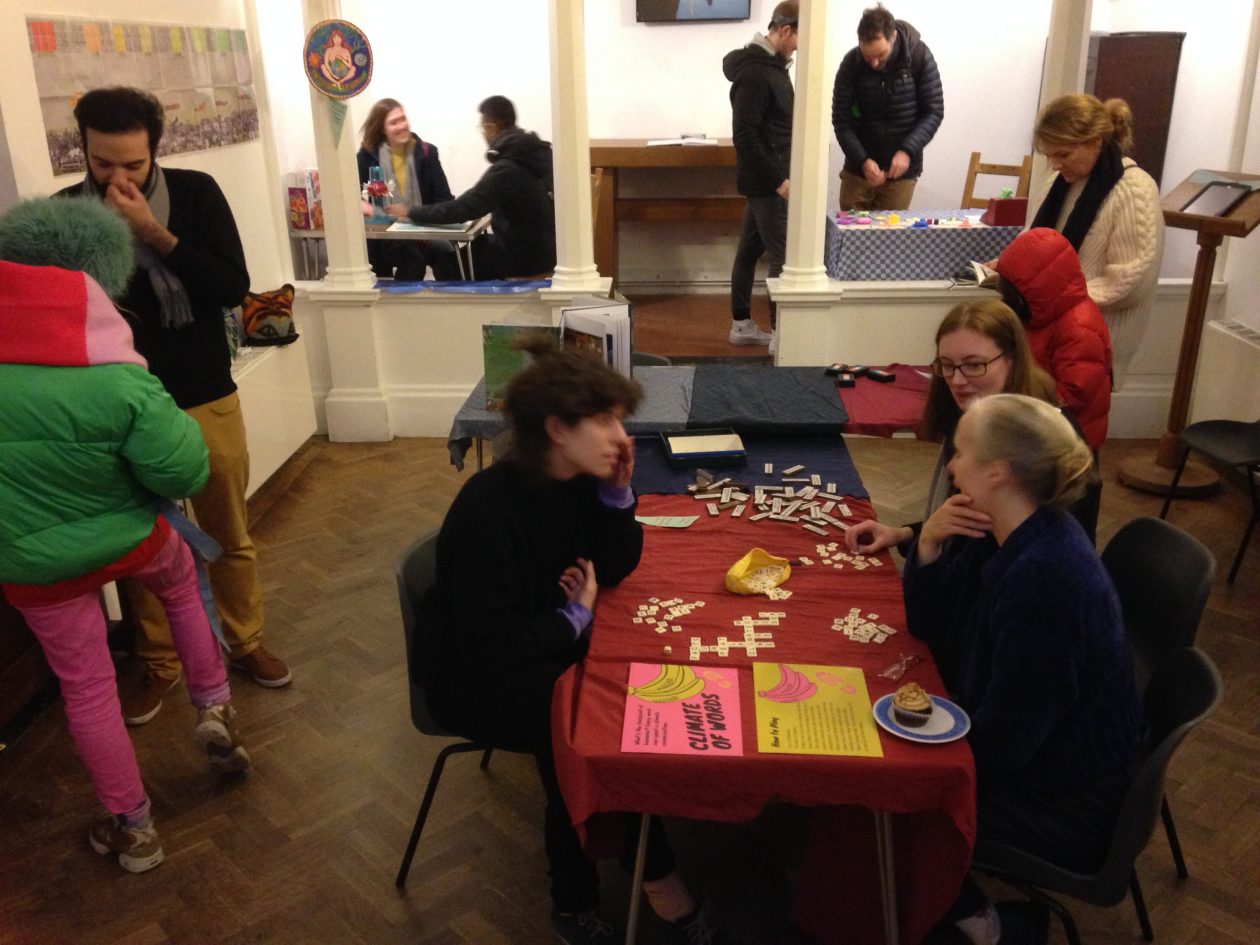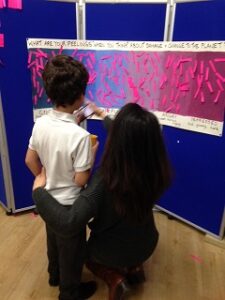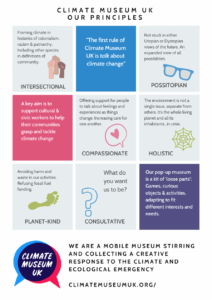
JULIA LEE BARCLAY-MORTON – YOGA, WATER AND REWRITING AUTISM
I interviewed writer Julia Lee Barclay-Morton about her experience of autism. Julia began as an experimental dramatist in New York, moving to the UK to

I asked the founder of Climate Museum UK, Bridget McKenzie, about everything she has done to build up this new project, and how the museum aims to help people understand climate change.
Leslie: Can you update us, please, on what Climate Museum UK does, where the idea came from, and how it began?
Bridget: We are an emerging mobile museum creatively stirring responses to the climate emergency. We support organisations to explore climate change (and related issues) in ways that help their communities to learn, create and take positive action. In turn workers will be more able to continue engaging with climate change in ways that are relevant to their purpose and place.

The core activity is a pop-up museum: a selection of props, infographics, games, activities and artworks that can be installed differently to suit each host organisation. The pop-up is installed through a one-day workshop with staff and supporters, then, when ready, opened up to a target group or wider public. There’s also a lot of digital collecting and amplifying, and participating in a range of campaign events and advocacy initiatives in different ways.
The idea comes out of my experiences in cultural engagement and environmental activism over the past 13 years or so. I’ve come up with many projects but each has dwindled as they perhaps lacked a concrete manifestation, and I needed to sustain my family. There hasn’t been a lot of funding for, or paid work in, this area. In 2017 I went on a Creative Climate Leaders course set up by Julie’s Bicycle. This encouraged us to define a project idea to further our creative climate leadership – aiming for effective systemic change. I decided to form a programme of professional development, helping cultural workers understand and tackle the climate and ecological emergency. It would draw on and extend the tools in my Possible Culture project.
Then at a conference in Museums and Climate Change last year I met some of the team from New York’s Climate Museum. The founder, Miranda Massie, was astounded that nobody had taken the Climate Museum name when she initiated the project in 2015. She was happy for others elsewhere to take the name. I decided, in order to make my vision more concrete, more public-facing and more playful, to set up a Climate Museum for the UK.
Other inspirations include mobile museums such as the Migration Museum, Museum of Homelessness and the Empathy Museum. There is a growing number of small and alternative museums, challenging the notion of what museums can be, collecting around contemporary issues, often collaborating with established museums to stretch their practice.
It began in summer 2018 with a first prototyping workshop during the Season for Change.
Leslie: As you’ve progressed, who/what has helped you with your project, and how?

Bridget: So far, it’s a one-man band with a huge amount of people wanting to play. There has been a lot of interest, and three prototyping events I’ve run have been oversubscribed. I have had support from my husband and daughter, helping me make a lot of the museum’s tools. My business partner (in Flow Associates) Susanne Buck has asked a lot of provocative questions about ‘what exactly is this?’ and how it fits with our consultancy work in public engagement in arts, heritage and science. Several people have been very helpful: Lucy Carruthers, an exhibition designer, has been invaluable at prototyping events and has rallied some colleagues to devise logo ideas for us. Judith Knight at Arts Admin and Siobhan Forshaw at St Margaret’s House have offered free space for our first prototypying pop-ups. Lots of supportive people online have amplified Climate Museum UK and invited me to participate in events – such as Anna Orridge and Lola Perrin. In order to formalise and ease the help that people want to give, I need to establish it as an organisation with a board of trustees.
In terms of ‘what’ has helped, I could add the rise in awareness of the climate & ecological emergency thanks to Extinction Rebellion and School Strike for Climate. I don’t want to thank the fact that this is due to the growing speed and severity of the emergency, but I acknowledge it.
Leslie: How have you involved people and what feedback have they given to you?
Bridget: I’ve been pretty transparent, exposing changes of mind and uncertainty. I send monthly emails to around 100 supporters, and usually ask for ideas. The whole process of development is participatory prototyping, and then even when the tools are more developed, each installation workshop will still be a learning process.
After the first trial pop-up, I wrote this blogpost summing up how it went. We got feedback from both the workshop participants, who installed the museum, and the visitors who dropped in. Key points were that we need more content about solutions and ecological innovations, and that we need more collateral to announce and describe who we are.
Leslie: What have been your most successful initiatives so far?

Bridget: I’d say it was the pop-up event described above. It was good to make a partnership with St Margaret’s House, who have offered to host future events. A lot of people dropped in, and were really interested. An architect, Tom Raymond, came and expressed interest in helping us create space or a travelling pod. And other meetings have come out of it.
Leslie: What changes have you decided to make?
Bridget: From the first pop-up, I could see that the most open-ended games were the most useful for promoting conversation, so we’re refining those. It also made me realise that we won’t be ready for some time to start running a full-on workshop with a complete kit, that we can confidently charge for. The next few months will involve all kinds of different trials in different settings, growing support and refining the tools. In early October, we should be ready for the first full-on installation – at the ONCA Gallery in Brighton.
Leslie: What have been the surprises so far in running this project?
Bridget: That’s a good question but one that is hard to answer. Lots of learning, which can have a surprising dimension. I’ve been pleased, if not quite surprised, at the amount of support and interest this has been getting. I’ve surprised myself that I’ve been motivated to sacrifice a lot of spare time. All kinds of things have been sacrificed – getting out to nature or cultural events, playing guitar, cleaning the house, relaxing, local activities, as well as some income – but it feels right to do. However, it isn’t sustainable so the next step is to get established, get funded and get people.
Next week I interview arts activist Nancy Stevens, finalist for Best Radio Presenter 2018 and winner of the 2017 Milton Keynes Inspirational Award.
ABOUT LESLIE TATE’S BOOKS:

I interviewed writer Julia Lee Barclay-Morton about her experience of autism. Julia began as an experimental dramatist in New York, moving to the UK to

I interviewed Gillean McDougall from Glasgow, who edited the collaborative projects Honest Error (on Charles Rennie Mackintosh and his wife Margaret Macdonald) and Writing the

I interviewed French writer Delphine de Vigan, whose book, No et moi, won the prestigious Prix des libraires. Other books of hers have won a clutch

I interviewed Joanne Limburg whose poetry collection Feminismo was shortlisted for the Forward Prize for Best First Collection; another collection, Paraphernalia, was a Poetry Book Society Recommendation. Joanne

I interviewed Katherine Magnoli about The Adventures of KatGirl, her book about a wheelchair heroine, and Katherine’s journey from low self-esteem into authorial/radio success and
| Cookie | Duration | Description |
|---|---|---|
| cookielawinfo-checkbox-analytics | 11 months | This cookie is set by GDPR Cookie Consent plugin. The cookie is used to store the user consent for the cookies in the category "Analytics". |
| cookielawinfo-checkbox-functional | 11 months | The cookie is set by GDPR cookie consent to record the user consent for the cookies in the category "Functional". |
| cookielawinfo-checkbox-necessary | 11 months | This cookie is set by GDPR Cookie Consent plugin. The cookies is used to store the user consent for the cookies in the category "Necessary". |
| cookielawinfo-checkbox-others | 11 months | This cookie is set by GDPR Cookie Consent plugin. The cookie is used to store the user consent for the cookies in the category "Other. |
| cookielawinfo-checkbox-performance | 11 months | This cookie is set by GDPR Cookie Consent plugin. The cookie is used to store the user consent for the cookies in the category "Performance". |
| viewed_cookie_policy | 11 months | The cookie is set by the GDPR Cookie Consent plugin and is used to store whether or not user has consented to the use of cookies. It does not store any personal data. |
One Response
This is a really interesting project from a thoughtful and committed rebel who is using her expertise to generate creative thought and connections in others.